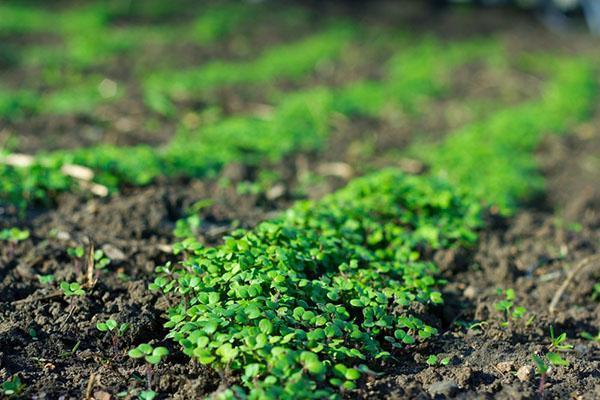Fertilizing and protecting the garden with mustard
 A priceless green fertilizer sprouts from a small grain. Mustard has such a unique property, which serves not only as a spice, but also siderat... For a vegetable garden, the white variety of cruciferous plants - "Synapsis Alba", is best suited. As a result, the farmer will forget about weeds, pests and mulching.
A priceless green fertilizer sprouts from a small grain. Mustard has such a unique property, which serves not only as a spice, but also siderat... For a vegetable garden, the white variety of cruciferous plants - "Synapsis Alba", is best suited. As a result, the farmer will forget about weeds, pests and mulching.
Dozens of years of experience
Millions of farmers successfully use this plant on their lands. Experience eloquently confirms the delightful effects of culture on the soil:
- prevents weeds from developing, because they germinate faster for them;
- retains nitrogen, preventing the leaching of both garden and garden land;
- makes the structure of the soil loose;
- releases phosphates, which dissolve for a long time and under special conditions;
- enriches follower plants with phosphorus, as well as nitrogen;
- serves as an excellent honey plant, which contributes to the pollination of other "inhabitants" of the garden.
Replaces mulching. After sowing in the fall, the greens freeze, turning into an excellent shelter that protects the soil from abnormal natural phenomena. At the same time, the grass layer retains a sufficient amount of moisture.
Potatoes get along well with her, beans, grapes and fruit trees. Mustard green spaces stimulate their growth and development, protecting against:
- scab;
- phytophthora;
- wireworm;
- putrefactive microorganisms;
- moths;
- teardrop.
The culture perfectly adapts to different types of soil and climatic conditions. Young shoots can withstand temperatures as low as -5˚С. The seeds are very small, so farmers simply sow them to create a thick grassy carpet. Otherwise, planting the seeds is practiced separately. The bushes grow sprawling and luxurious.
It is impossible to deepen the seeds, then the growth and development of culture slows down. For loose sandy soils, the furrow depth is up to 2 cm, and for clayey soils - 1 cm. After 3-4 days, shoots can be expected to appear.
The clock is ticking
The question of time is always relevant. Some people prefer to sow mustard in the spring. In April, when the temperature is at around + 10 ° C, sowing work is carried out. A month later, I dig it up / plow it up to get fertilizer and protect the garden from weeds. In this case, the culture is cut off before flowering appears, otherwise you will have to remove the hardened stems. After these procedures, they are engaged in planting potatoes and other crops.
At the same time, it is not suitable for the neighborhood with cabbage, radish and lettuce. The reason is that the same pests eat them.
Autumn sowing is planned after harvest. It is worth remembering that the plant will need 5-7 weeks of warm days before flowering. In addition, it can be planted in winter so that seedlings appear in the spring. Only here you need not make a mistake with time The sprouts can sprout, smelling the heat, and then everything is gone. Therefore, the ground should already be cold, and it is worth deepening the seeds by 2-4 cm, because the melt water wash off the top layer. Nevertheless, the gardener cannot do without mineral fertilizers.